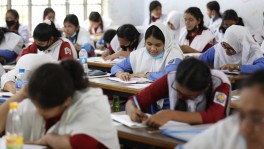Dream shines on troubled water
Prime Minister Sheikh Hasina’s commitment, determination and self-belief pay off in achieving the glorious feat

With the clock striking 7:30am, a throng of people start to turn up at Shimulia Ghat amid a blanket of fog to witness the prideful moment when a dream comes into reality.
As the day progresses, fog begins to fade away with the sun peeping out from the edge of mists. At 9am, all head for pillars 12 and 13.
Less than an hour afterwards, sensing the whirring of the Tiyan E, the world's largest floating crane, newsmen and camera crew are on full alert to share with their audience the historic moment of installation of the final span on the Padma Multipurpose Bridge.
The process began at 9:40am and completed at 12:02 sharp, making the entire 6.15-kilometre bridge from Munshiganj's Mawa to Shariatpur's Zajira visible.

Thus, a shroud of clouds over the construction of the much-sought-after Padma Bridge has disappeared just like the way the final span sits on the bridge with morning fog having worn off.
Getting a Tk30,193 crore ($3.6 billion) project done with own finance demonstrates the country's growing capacity to venture on and fund mega projects.
But the journey to materialising this biggest dream project was not as smooth as it appears now. It is a long tale of hurdles – what mainly put this mega project in uncertainty was the financial encumbrance after the World Bank pulled out of it with its promised funding in 2012, citing an allegation of corruption.
Also Read-
Padma Bridge's last span installed
Padma Bridge world's 122nd longest bridge
Padma Bridge: How the dream project came true
How the country paid for the dream project
On 30 September 2017, the Padma Bridge started becoming visible with the installation of the first span on pillars 37 and 38. After 38 months, work on installing all spans has been completed.
Bridges Minister Obaidul Qauder was present on the spot when the first span was installed to celebrate the prideful occasion. However, this time, the government avoided any festivity because of the pandemic.
The China Major Bridge authorities did have any additional arrangements either. There were extra security measures during the installation work.
Bigger dreams await
Once the construction of the bridge is completed, people of 29 districts will now wait to see their dreams come true: travelling to Dhaka by road and rail without hassles at ferry ghat and rush for risky speed boats to cross the river.
Entrepreneurs, who already bought land along the highway leading to Barishal, will accelerate work on their planned industries.
The World Bank – which once was involved in the project - estimates that this will increase the size of the country's gross domestic product (GDP) by 1.23%.

The increased GDP size will be closer to the total grant of ADB and Japan International Cooperation Agency (Jica). Besides, the feasibility study report also said about 7.5 lakh people will be employed when the project is completed.
The Implementation Monitoring & Evaluation Division (IMED) has conducted a survey among potential users of the bridge.
According to the IMED survey, about 96% of the people said the bridge will help ensure fair prices to their agri-produces. In the meantime, 97% of respondents think that the bridge will increase employment in the transport sector.
Nearly 100% of the respondents believe the bridge will improve their access to education and health services since it will facilitate the transportation network. Around 86% of the potential beneficiaries of the project think that the transportation system will be safer thanks to the Padma Bridge.
However, only 30% of the respondents think that their income will increase owing to the bridge.
The economic conditions in northern districts witnessed a significant change with the inauguration of the Jamuna Bridge in 1994 as the bridge connected them with other parts of the country.
Thus, the "monga", a seasonal famine-like situation in the northern districts, had gradually been shown an exit after small industries were set up, thanks to the good communication system.
Farmers also increased agricultural production as they can fetch good profits by selling their produce for the improved transport facilities.
Economists believe that the under-construction Padma Bridge will play a similar role in regional development.
Moreover, they think exports through the Mongla port will increase. And, the opportunities for export-import with India by land will also be created.
Economist Ahsan H Mansur, executive director of the Policy Research Institute, said the Padma Bridge will increase scopes for industrialisation in the country's south-western region, resulting in an increase in employment opportunities.
Things to be done
Apart from the installation of spans, other works on the Padma bridge project are also in progress.
However, the bridge's construction is not going to be completed by June next year. It is also not possible to launch the bridge on Victory Day next year as announced by Bridges Minister Obaidul Quader.
Cabinet Secretary Khandker Anwarul Islam at a function on Wednesday announced that the bridge would be opened for traffic by June 2022.
Project sources said the two-tier metal and concrete bridge will have cars to ply on the upper section and trains on the lower level. There will be 2,917 roadway slabs for roads and 2,959 slabs for trains.
According to a press release sent by the Bridges Division on Wednesday, 1,333 roadway and 1,942 railway slabs of the main bridge have so far been installed.
Some 321 out of 484 super girders have been set up in Mawa and Zajira viaducts. The overall progress of the main bridge is 91%.
On the other hand, work on the approach roads, connecting Mawa with Zajira, has been completed. The overall progress of the project is 82.50%.
According to sources, the Padma Bridge is being constructed, targeting a lifespan of 100 years. But, work on river training – which is considered to be more important in protecting this bridge – has remained far behind. This most important work has witnessed a 76% progress.
Md Shafiqul Islam, project director of Padma Multipurpose Bridge Project, said the river training work has slowed down because of Covid-19. That is why it will not be possible to finish the project in the stipulated time.
When asked about the bridge's inauguration date, the project director said the bridge authorities have not announced any date yet. They have already informed the authorities that the bridge will not be completed next year.
The Padma Multipurpose Bridge – the biggest state-funded infrastructure project in Bangladesh's history, came into reality because of Prime Minister Sheikh Hasina's firmness and confidence in implementing the dream mega project with own funds.
"We ourselves can start work on the bridge," she had announced in the budget session in 2012 after the World Bank and others withdrew from the project raising allegations of bribery conspiracy.
The allegations were later proved untrue by a Canadian court in 2017.
Controversy, uncertainty from the very beginning
The World Bank, the Asian Development Bank (ADB), Jica and Islamic Development Bank (IDB) pledged $1,200 million, $615 million, $415 million and $140 million in loans respectively for the Padma Bridge project – a $290 crore infrastructure to bring the people of 19 southwestern districts of Bangladesh under better connectivity.
However, on 30 June 2012, the World Bank decided to refrain from financing the project, raising corruption allegations. Other donors also took the World Bank lead.
The global lender then offered to join the project on a number of conditions, including bringing the officials involved in so-called "bribery scam" to book.

Despite several initiatives taken by the government, including arresting the then secretary of the Bridges Division, the standoff between the global lender and the government remained unresolved. After a cabinet meeting in July that year, Prime Minister Sheikh Hasina came up with the announcement to implement the project at the government's own cost.
At that time, she requested the affluent people and organisations to finance the project. Subsequently, a bank account was opened in state-owned Sonali Bank, which got around Tk12 crore deposits too.
The then Indian President Pranab Mukherjee proposed a $200 million grant in the project from India's $1,000 million loan to Bangladesh. Apart from this, the government decided to support the remaining spending of the project from its own pocket.
Even the then finance minister Abul Maal Abdul Muhith commented that it would be difficult to build the bridge with cent percent government financing. Moreover, experts then opined that the project financing could risk allocations in other major sectors such as education, health and social security.
In addition to financing, design flaws, structural complexity of the riverbed, strong current and lack of navigability delayed construction of the bridge. Lastly, the pandemic hit the project since the foreign workers, consultants and many project staffers left the construction site.
Project cost tripled
In August 2007, the Executive Committee of the National Economic Council (Ecnec) approved the Padma Bridge construction project at a cost of Tk10,162 crore with the deadline of 2015. However, the work was supposed to be completed in 2013 when the bridge was designed.
In 2011, the government approved the first revised project with the cost nearly doubled to Tk20,507.20 crore. In 2016, the project was revised for the second time raising the cost to Tk28,793 crore, and the deadline was extended to December 2018.
In June 2018, another special revision for the project was approved hiking the cost further by 47.23% to Tk30,193.39 crore.
In November 2019, the Planning Commission approved a proposal extending the deadline to June 2021, on the condition that the project deadline would not be extended again.
However, the construction will not be completed within the time, said the project director Md Shafiqul Islam.
He told The Business Standard that the pandemic had already delayed the project. The span was supposed to be installed by last June, but it was not possible due to the virus outbreak in the country. Against the backdrop of such reality, it will not be possible to conclude the work by June, 2021.
IMED recommends rehabilitation of the affected
The IMED report further said that the project risks small employment in the area since it will bring in a change to income sources of the locals. The IMED has urged the government to make arrangements for the locals who got affected by the bridge.
The report says demolishing the previous jetty for the construction site affected the traders there. Currently, there are 11 ferries, 80 launches and about 90 speedboats to ferry people across the river. The IMED also said there will be a shortage of jobs for those people once the bridge is completed.

Taizul Islam, a local boatman, makes a living by transporting passengers and goods to the construction site. He recently bought another trawler and rented it out from his savings.
The four-member family of Taizul is doing well with the income from the two sources.
Expressing a bit of disappointment, he said, "Once the bridge is opened for traffic, the income of thousands of people including us will be stopped. Those who work as day labourers might manage another job in factories. But people like me who earn a bit more than a day laborer will be in trouble."
Long waiting hours for ferries will end
The Bangladesh Inland Water Transport Corporation (BIWTC) suspended the ferry services from Shimulia Ghat at 10:00 pm Tuesday as dense fog reduced the visibility to just a few meters.
Ariful Islam and Shamima Islam left Dhaka for Khulna at 9.30 pm and missed the last ferry. They had to stay on the jetty for the rest of the night for the fog to abate.
When the ferry service resumed in the morning, there had been talks about the bridge. The couple was eagerly waiting for the construction to complete.
They said the opening of the bridge will reduce the travel time from Dhaka to Khulna by at least two hours. And many others like them will be freed from the sufferings prompted by waiting at the terminal for hours.


 Keep updated, follow The Business Standard's Google news channel
Keep updated, follow The Business Standard's Google news channel
















